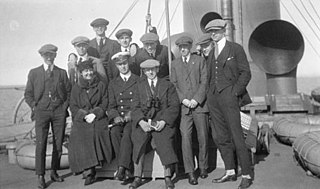
Rowing at the 1920 Summer Olympics, the first Olympics after World War I, saw five events. The competitions were held from 27 to 29 August in Antwerp, Belgium.

Switzerland competed at the 1920 Summer Olympics in Antwerp, Belgium. 77 competitors, all men, took part in 45 events in 13 sports.

Jenő Fuchs was a Hungarian sabre fencer. He competed at the 1908 and 1912 Olympics and won both the individual and team events at both Games. He missed the 1920 Olympics, where Hungary was not allowed to compete, and qualified for the 1924 Games, but left his place in the team to younger fencers. In 1982 he was inducted into the International Jewish Sports Hall of Fame.

Paul Eugène Albert Anspach was a Belgian épée and foil fencer who competed in four consecutive Olympics.
Peggy Waleska is a German rower.
Wilhelm Brüderlin was a Swiss rower who competed in the 1920 Summer Olympics.
Max Rudolf was a Swiss rower who competed in the 1920 Summer Olympics.
Paul F. Rudolf was a Swiss rower who competed in the 1920 Summer Olympics. In 1920 he was part of the Swiss boat, which won the gold medal in the coxed fours event. He was also a member of the Swiss eights which was eliminated in the first round of the eight competition.
Hans Walter was a Swiss rower who competed in the 1920 Summer Olympics and in the 1924 Summer Olympics.
Alfred Felber was a Swiss rower who competed in the 1920 Summer Olympics and in the 1924 Summer Olympics.

The men's coxed pair event was part of the rowing programme at the 1920 Summer Olympics. The competition was held on 28 and 29 August 1920. It was the second appearance of the event, which had previously been held only at the inaugural rowing competitions in 1900. Four boats, each from a different nation, competed. The event was won by the Italian boat in that nation's debut in the event, with Ercole Olgeni and Giovanni Scatturin the rowers and Guido De Felip the coxswain. France's crew took silver, the second consecutive silver for France. Switzerland earned bronze.

The men's coxed pair event was part of the rowing programme at the 1924 Summer Olympics. The competition, the third appearance of the event, was held from 14 to 17 July 1924 on the river Seine. Five teams, each from a different nation, competed, for a total of 15 rowers and coxswains. The event was won by Switzerland, with rowers Édouard Candeveau and Alfred Felber and coxswain Émile Lachapelle. The two Swiss rowers had earned bronze in 1920 with a different cox. Defending champion Italian rowers Ercole Olgeni and Giovanni Scatturin took silver, this time with Gino Sopracordevole as their cox. Candeveau, Felber, Olgeni, and Scatturin were the first four men with multiple medals in the event. The United States' debut in the event netted a bronze medal for rowers Leon Butler and Harold Wilson and cox Edward Jennings.
Otto Bucher was a Swiss rower who competed in the 1928 Summer Olympics and won the silver medal as member of the Swiss team in coxed four.

Fritz Bösch was a Swiss rower who competed in the 1928 Summer Olympics and won the silver medal as member of the Swiss team in Coxed four.
Joseph Meyer was a Swiss rower who competed in the 1928 Summer Olympics and won the silver medal as member of the Swiss team in coxed four.
Ernst Haas was a Swiss rower who competed in the 1928 Summer Olympics and won the silver medal as member of the Swiss team in coxed four.

The 1920 Summer Olympics ice hockey rosters consisted of 60 players on 7 national ice hockey teams. Played at the Olympic Games for the first time, and later regarded by the International Ice Hockey Federation (IIHF) as the first World Championship. Teams were required to be strictly amateur, so players from the Canadian-based National Hockey League (NHL) or other professional leagues were excluded. Canada sent the Winnipeg Falcons, who had won the 1920 Allan Cup, the amateur championship in Canada.

Events from the year 1957 in Romania. During the year, Romania hosted the first European competition for female artistic gymnastics. The country enacted laws to ban prostitution and slavery, and provide for abortion on demand. Notable deaths include the sculptor Constantin Brâncuși.
Events from the year 1964 in Romania. The year saw increasing separation from Soviet influence.








